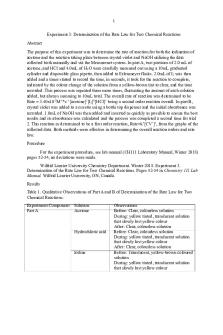Experiment 07 - newtons second law PDF

| Title | Experiment 07 - newtons second law |
|---|---|
| Course | Physics I |
| Institution | New York University |
| Pages | 2 |
| File Size | 60.6 KB |
| File Type | |
| Total Downloads | 64 |
| Total Views | 140 |
Summary
newtons second law...
Description
Huan Li PHY 121 Experiment#7 Newton's 2nd law - Lab report April 7, 2021 Objective: To observe the relationship between force and acceleration and to test the hypothesis that the force is equal to the mass times the acceleration (Newton’s Second Law). Experiment Principle: When studying the relationship between acceleration and mass M and external force F, the quality is kept unchanged, the acceleration of the object under the action of different forces is measured, the relationship between acceleration and force is analyzed, and then the force of the object is the same, the acceleration of objects of different mass is measured under the force, and the relationship between acceleration and mass is analyzed. This method of controlling certain parameters unchanged first and studying the relationship between changes between two parameters is called the method of controlling variables. Procedure: 1. Measure the quality of the car and the quality of the small disk by balance, M0, m0, respectively, and record the value. 2. Install the experimental equipment as shown (no tethers on the trolley). 3. Balance friction: a thin plank is placed under one end of the long plank without pulleys, so that the car can move in a straight line along the plank without hanging small plates and weights. In this way, the gravity of the car is balanced along the plank with the sliding friction of the car. 4. Tie the small plate to the car by string, turn on the power to release the car, record the movement of the car with paper tape, remove the paper tape and mark the number on the paper tape and the gravity m0g of the small plate hanging at this time. 5. Keep the quality of the car unchanged, change the number of weights in the small disk, repeat step 4 to do a few more experiments. Each car should be released from the same location and the appropriate paper tape recorded. 6. Keep the combined force of the car unchanged, add weight to the car, and measure the total quality M after the car and put on the weight, turn on the power to release the car, record the movement of the car with paper tape, remove the paper tape and mark the number on the paper tape.
7. Continue to put weights on the car, repeat step 6, do a few more experiments, in each time the resulting paper tape marked with the number. Conclusion: According to the results of data processing, it can be concluded that: within the margin of error, the experiment is consistent with Newton's second law, that is, acceleration is proportional to the combined force and inversely proportional to mass. The experimental error mainly comes from the following aspects: 1. The rail is not fully adjusted; 2. The effect of air resistance, the influence of fine line, sheave movement resistance; 3. Impact of airflow fluctuations; 24. The local gravity acceleration is approximately 980cm/s. 5. Weight quality error. The effect of various resistances, such as air, on the experiment may be the main one. Because the air resistance is generally proportional to the secondary side of the speed, so the pull force in the experiment cannot be too large, otherwise the acceleration is large, the speed increases fast, the air resistance increases fast; But the pull force cannot be too small, otherwise very small resistance will also have a greater impact....
Similar Free PDFs

Newtons second law
- 3 Pages

Chapter 4 - Newton’s Second Law
- 5 Pages

Experiment 1 HESS\'S LAW
- 6 Pages

LAB Report Newton\'s Second Law
- 6 Pages

Experiment 4 Hookes LAW
- 6 Pages

Experiment 24-Rate Law
- 11 Pages

Experiment 3, Rate Law Determination
- 14 Pages
Popular Institutions
- Tinajero National High School - Annex
- Politeknik Caltex Riau
- Yokohama City University
- SGT University
- University of Al-Qadisiyah
- Divine Word College of Vigan
- Techniek College Rotterdam
- Universidade de Santiago
- Universiti Teknologi MARA Cawangan Johor Kampus Pasir Gudang
- Poltekkes Kemenkes Yogyakarta
- Baguio City National High School
- Colegio san marcos
- preparatoria uno
- Centro de Bachillerato Tecnológico Industrial y de Servicios No. 107
- Dalian Maritime University
- Quang Trung Secondary School
- Colegio Tecnológico en Informática
- Corporación Regional de Educación Superior
- Grupo CEDVA
- Dar Al Uloom University
- Centro de Estudios Preuniversitarios de la Universidad Nacional de Ingeniería
- 上智大学
- Aakash International School, Nuna Majara
- San Felipe Neri Catholic School
- Kang Chiao International School - New Taipei City
- Misamis Occidental National High School
- Institución Educativa Escuela Normal Juan Ladrilleros
- Kolehiyo ng Pantukan
- Batanes State College
- Instituto Continental
- Sekolah Menengah Kejuruan Kesehatan Kaltara (Tarakan)
- Colegio de La Inmaculada Concepcion - Cebu








